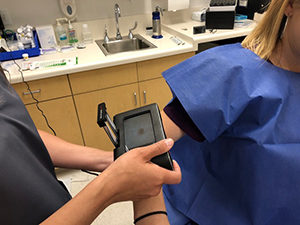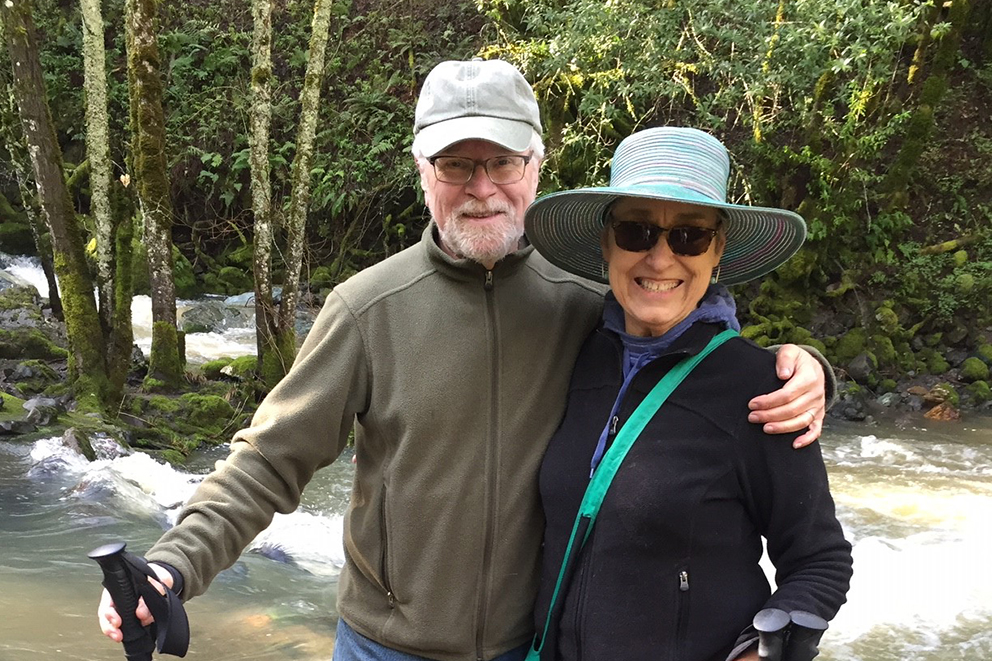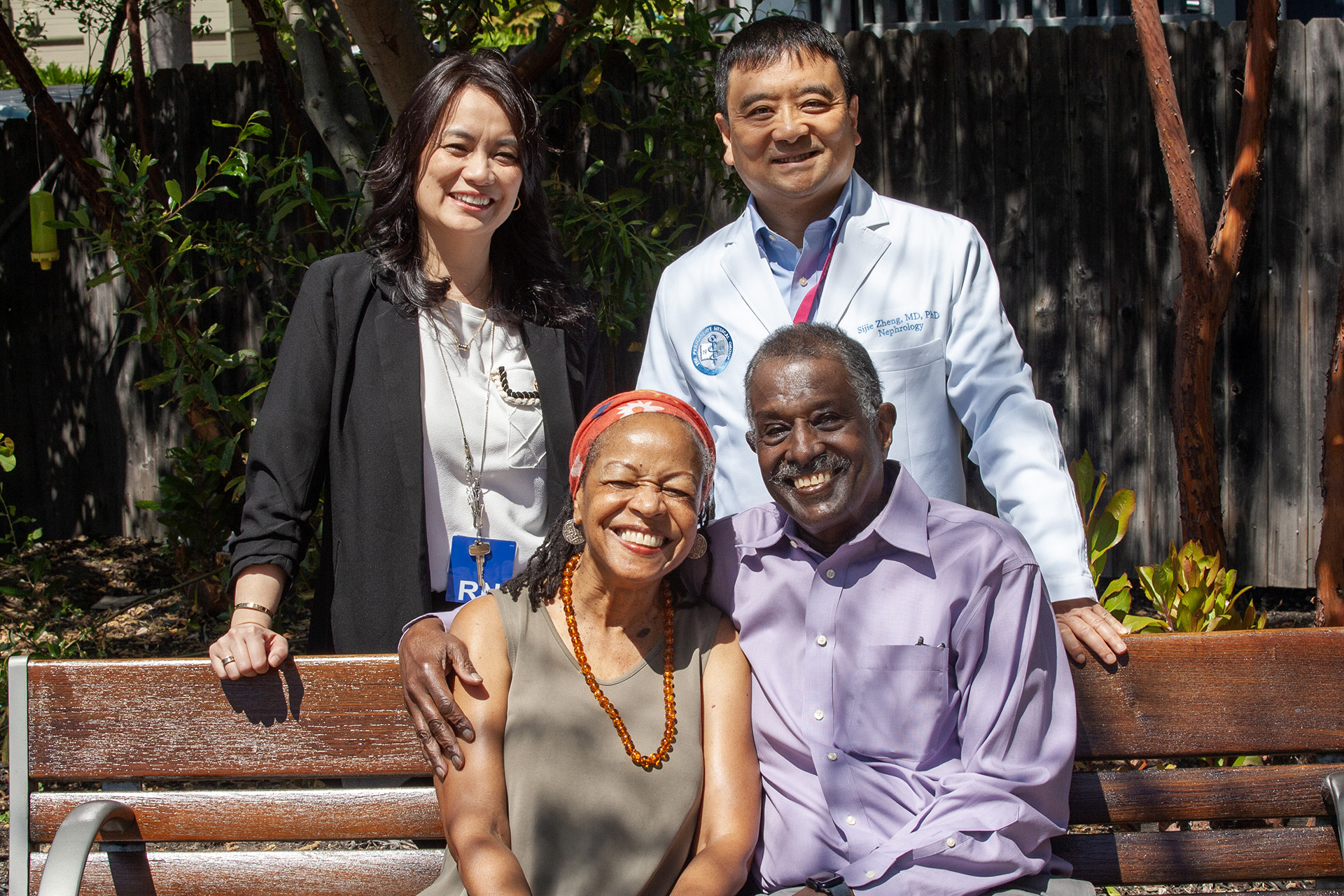In honor of Skin Cancer Awareness Month this May, read about Kaiser Permanente Northern California’s innovative teledermatology program. Pictured, Kaiser Permanente employee David Ebright and his wife Marsha Taylor on a hike.
First, David Ebright noticed a “suspicious” mole on his stomach.
He snapped a picture and sent it to his doctor via kp.org; his doctor told him to come in for a closer look.
“My primary care physician confirmed that, yes, the mole looked suspicious. He took a photo with a special camera and emailed the image to the dermatologist,” said Ebright, a public affairs manager for Kaiser Permanente in Marin and Sonoma.
Ebright’s doctor used a digital camera fitted with a dermatoscope, which is a strong magnifying glass coupled with a bright light that can be optimized to look at the surface of the skin or the layers underneath.
Less than 48 hours later, Ebright got a call from Mark Cheiken, MD, a dermatologist at the Kaiser Permanente Santa Rosa Medical Center.
“He said I needed to come in. I scheduled an appointment and he biopsied it, which confirmed melanoma. I went in for outpatient surgery and a surgeon did a further excision of the mole and the margin around it,” Ebright said. “I got an email a few days later: ‘Good news, no cancer!’”
An Innovative Program
Kaiser Permanente’s teledermatology program in Northern California has been in place for more than a decade, and it is believed to be one of the largest anywhere, with an estimated 150,000 interactions between physicians and patients in 2018 alone.

In a few of the region’s 21 medical centers, primary care physicians can request a “roving” dermatologist visit exam rooms and look at rashes and skin lesions, while at most medical centers physicians can take pictures and transmit them to on-call dermatologists before having patients come in for a visit in the dermatology department.
“One in 5 people in this country develops a skin cancer,” said Sangeeta Marwaha, MD, dermatologist at the Kaiser Permanente South Sacramento Medical Center and lead author of a Kaiser Permanente teledermatology study. “That’s a large and growing population that needs dermatological care. With teledermatology, we are looking for innovative ways to deliver fast and high-quality care to people who need it.”
More Cancers Found, Fewer Referrals
Dr. Marwaha’s study, conducted with Lisa J. Herrinton, PhD, research scientist with the Kaiser Permanente Division of Research, included nearly 60,000 adult members in Northern California who asked their primary care physician to take a look at a worrying skin lesion during the first half of 2017.
When Kaiser Permanente on-call dermatologists, in partnership with primary care physicians, had the opportunity to look at skin lesions well-photographed with the dermatoscope, they identified 9% more cancers with 39% fewer referrals to dermatology departments.
“Cancerous lesions have certain qualities such as irregular color and shape, bleeding, and textural crustiness that benign lesions don’t have,” Marwaha said. “The workflow using the dermatoscope and a high-resolution camera allowed the ability for us to see some of the lesion’s subtler qualities.”
May is Skin Cancer Awareness Month, and Ebright encourages Kaiser Permanente members to pay attention and act on their instincts when they notice something on their skin that doesn’t seem right.
“This happened on my stomach, on an area that is typically covered. But I just knew I had to go and check it out,” Ebright said.





This Post Has 5 Comments
My husband and I are out in the sun a lot, so I wanted tips and info on protecting our skin. I didn’t know primary care physicians could request a dermatologist to come to check on their patients for unusual skin lesions and rashes. I’ll have to keep that in mind. Thanks to this post, now I know!
I just turned 27, and I just had the Mohs surgery for a basal cell carcinoma near my eye. I too noticed the bump and went to see my PCP hoping to have it frozen off. He sent me to Telederm for a same-day appointment where they took a picture of the bump, 3 weeks later I saw a dermatologist who sent the specimen in for biopsy, and the results came back positive for basal cell carcinoma. I am fair-skinned, and never thought of myself as being in the sun too much when I was younger. Dr. Omlin in Vacaville took awesome care of me, the scar is very minimal, and the procedure was easy-peasy.
Nice to see you, David!!! And glad you got this taken care of!
In this article the majority of the cases were brought to their doctor’s attention because the patient/member was pro-active in recognizing a change or concerned. What happens to those patients that don’t notice a mole change on their body? Or can’t see it because it is on their back or on their scalp hidden by their hair? Shouldn’t annual mole/skin checks be part of preventative care and not have to wait until you happen to find it yourself?
Hi Arlene,
I’m glad you raised this very important question. The USPTF (U.S. Preventive Services Task Force) provides recommendations for prevention/screening of many forms of cancer. Their findings in regards to routine skin checks are the following: certain people with either a personal or strong family history of melanoma should receive routine skin screenings and for most other individuals there isn’t evidence to suggest that routine skin checks will change the course of their care if they do develop a skin cancer. I have my own bias as a dermatologist, but in general I agree that certain high risk individuals do benefit from regular skin checks by a medical provider. It doesn’t hurt to ask your primary care provider to check your skin while at your annual check up, and of course if a new or changing spot does come up to bring it to their attention. There is also evidence that a spouse or partner is likely to spot a skin cancer, so we encourage everyone to take time every once in a while to look at your partner’s back (and nowadays can even consider taking a photo with your phone for future comparison) to keep an eye out for new or odd looking spots.
We also know that the #1 modifiable risk factor to prevent skin cancer is sun protection and limiting excessive sun/UV exposure. I hope this information is helpful!
Kind Regards,
Kory